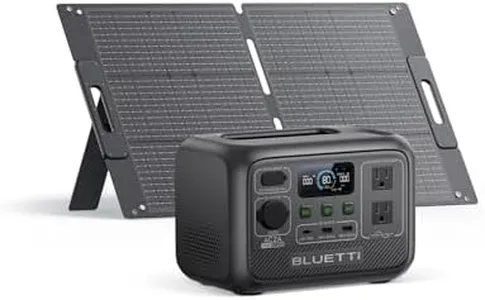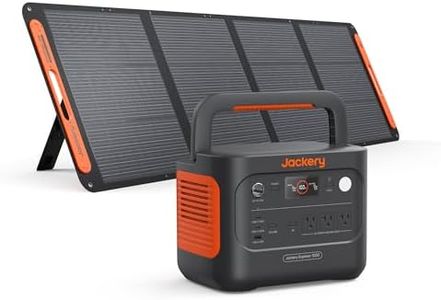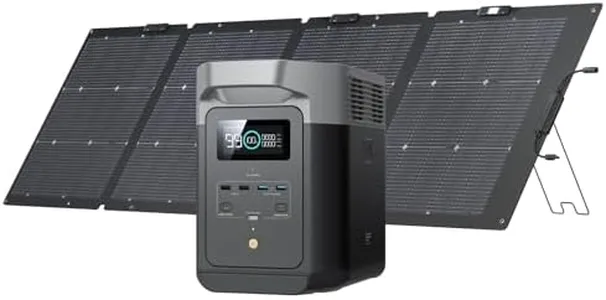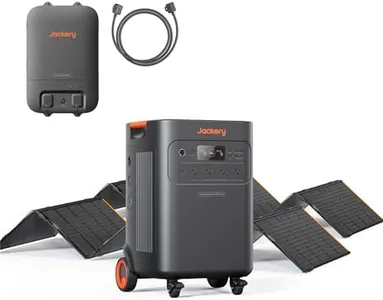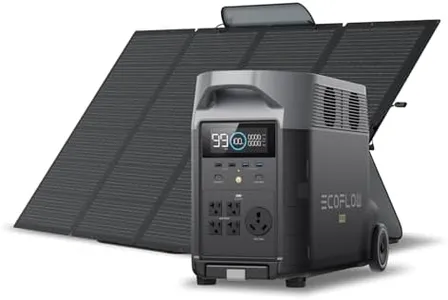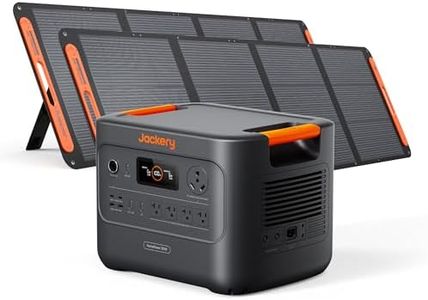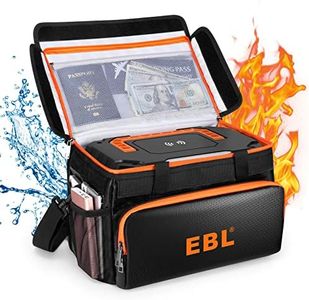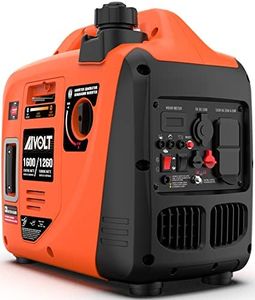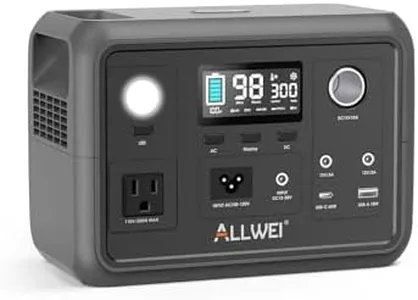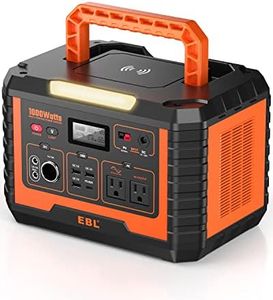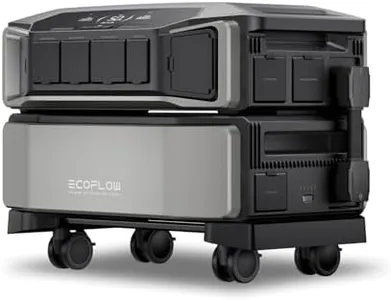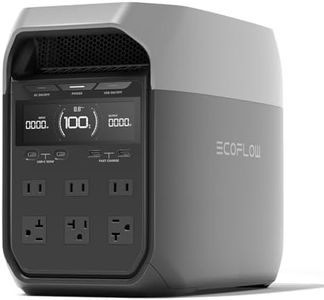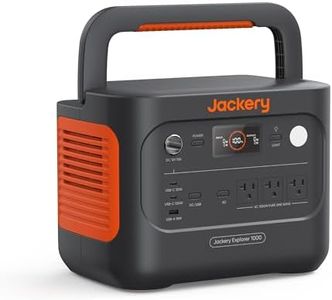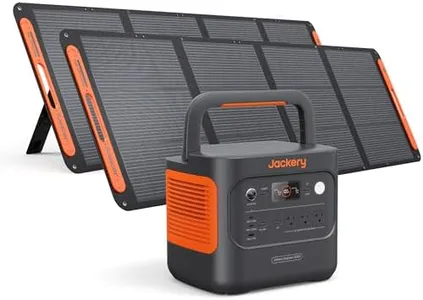10 Best Solar Backup Generators 2025 in the United States
Our technology thoroughly searches through the online shopping world, reviewing hundreds of sites. We then process and analyze this information, updating in real-time to bring you the latest top-rated products. This way, you always get the best and most current options available.

Our Top Picks
Winner
Jackery Solar Generator 1000 v2 with 200W Solar Panel,1070Wh Portable Power Station LiFePO4 Battery,1500W AC/100W USB-C Output, 1Hr Fast Charge for Outdoor,Off-Grid Living,RV,Emergency
Most important from
4142 reviews
The Jackery Solar Generator 1000 v2 is designed to be a powerful yet highly portable solution for those needing reliable power in various settings, like outdoor adventures or emergency situations. With a robust 1,500W AC output and a 3,000W surge peak, it’s capable of running multiple devices simultaneously, including demanding appliances like fridges and electric pots. Its battery capacity of 1,070Wh is substantial, providing ample power for extended periods.
Weighing just 23.8 lbs and featuring a foldable handle, it's easy to transport, making it ideal for outdoor enthusiasts or those living off-grid. The 200W solar panel compatibility ensures that you can recharge it sustainably, adding to its versatility for off-grid use. The inclusion of various charging options, including fast USB-C and multiple AC ports, means you can power a wide range of devices. The one-hour fast charging feature is particularly impressive, though it requires enabling the emergency charging function in the app each time.
Durability is a strong point with its LFP battery, designed to last over 10 years with a high cycle life. However, the need to use the Jackery App for certain features might be a drawback for those not keen on relying on apps for device management. Additionally, the separate shipping of the generator and solar panel could be a minor inconvenience. The Jackery Solar Generator 1000 v2 stands out for its powerful performance, portability, and durability, making it a solid choice for users needing a reliable and versatile power source.
Most important from
4142 reviews
EF ECOFLOW Solar Generator DELTA 2 with 220W Solar Panel, 1024Wh LFP(LiFePO4) Battery, 1800W AC/100W USB-C Output, Fast Charging Portable Power Station for Home Backup Power, Camping & RVs
Most important from
7295 reviews
The EF ECOFLOW Solar Generator DELTA2 with 220W Solar Panel is a reliable and versatile option for those needing backup power for home, camping, or RV trips. With a substantial battery capacity of 1024 watt-hours and a power output of 1800 watts, it can handle most household and outdoor appliances. The included 220W bifacial solar panel enhances energy capture by up to 25%, making it efficient for off-grid use. One standout feature is its durability, with the LFP battery offering a lifespan of over 3000 cycles, ensuring long-term use.
Fast charging capabilities mean the generator can be recharged quickly, which is a major plus for emergencies or frequent usage. Portability is decent, although at 58 pounds, it might be a bit heavy for some users to carry around easily. The device is highly versatile, with 15 different outlets and the ability to expand capacity from 1kWh to 3kWh by adding extra batteries.
However, its bulkiness and weight might be drawbacks for those looking for a more compact and lightweight solution. Additionally, while it offers numerous charging options (AC, car, solar), the initial setup might seem complex for some users. Nevertheless, for anyone needing a robust and efficient solar generator, this model, with its solid build quality and extensive features, is definitely worth considering.
Most important from
7295 reviews
Jackery Solar Generator 5000 Plus Portable Power Station with 2x 500W Solar Panels and Smart Transfer Switch, 5040Wh Power Station, 7200W AC Output Solar Generator for Home Use, Emergency Backup
Most important from
56 reviews
The Jackery Solar Generator 5000 Plus is a powerful and versatile solar-backup generator, perfect for home use and emergency situations. One of its standout features is its impressive battery capacity, offering 5040Wh, which is expandable up to 60kWh. This means it can power a whole home for over a day on a single charge, and potentially up to 15 days with maximum expansion.
The generator's power output is equally robust, with a 7200W AC output, making it capable of running heavy-duty equipment such as dryers, water pumps, and ovens, as well as everyday devices. It is equipped with dual voltage outputs (120V/240V), enhancing its versatility for various applications, including recharging RVs during travel. The inclusion of two 500W solar panels ensures it is highly compatible with solar energy, offering a clean and quiet alternative to traditional diesel generators.
The generator has a 0ms UPS mode that instantly switches to stored power during blackouts, ensuring critical devices remain operational without interruption. Moreover, the smart app control feature allows real-time monitoring and control via WiFi or Bluetooth, which is convenient for modern users. Despite its high capacity and output, the generator remains relatively quiet, operating at under 30dB. However, its large capacity and power output make it less portable compared to smaller models, and its weight is likely on the heavier side. Additionally, the price point may be a considerable investment for some users. Its high durability, expansive capacity options, and eco-friendly operation make it a strong candidate for those needing a reliable and powerful home backup solution or emergency power source.
Most important from
56 reviews
Buying Guide for the Best Solar Backup Generators
Choosing the right solar backup generator can be a game-changer for ensuring you have power during outages or when you're off the grid. The key to making the best choice is understanding your power needs and how different specifications of solar generators can meet those needs. Here are some important specifications to consider when selecting a solar backup generator, along with explanations to help you navigate through them.FAQ
Most Popular Categories Right Now
